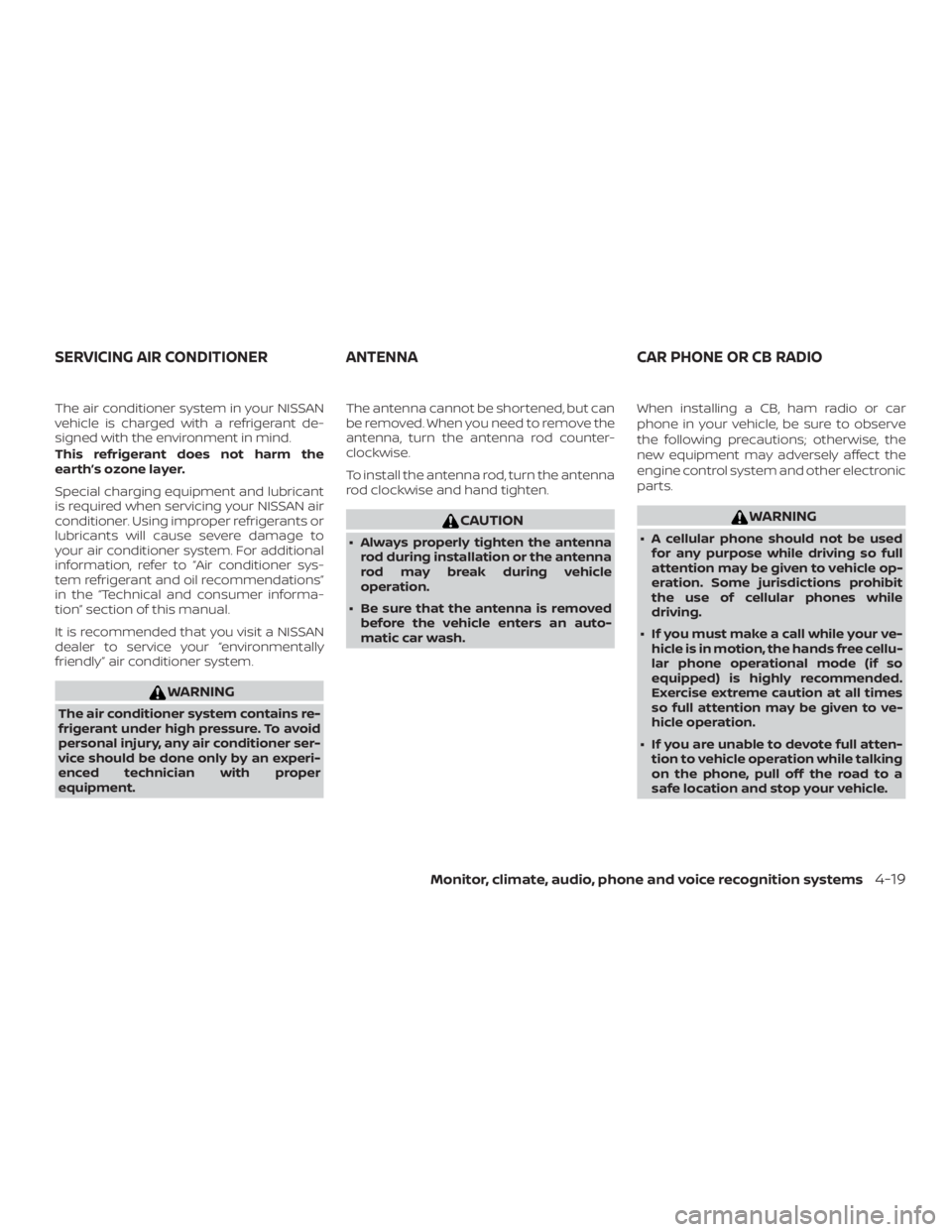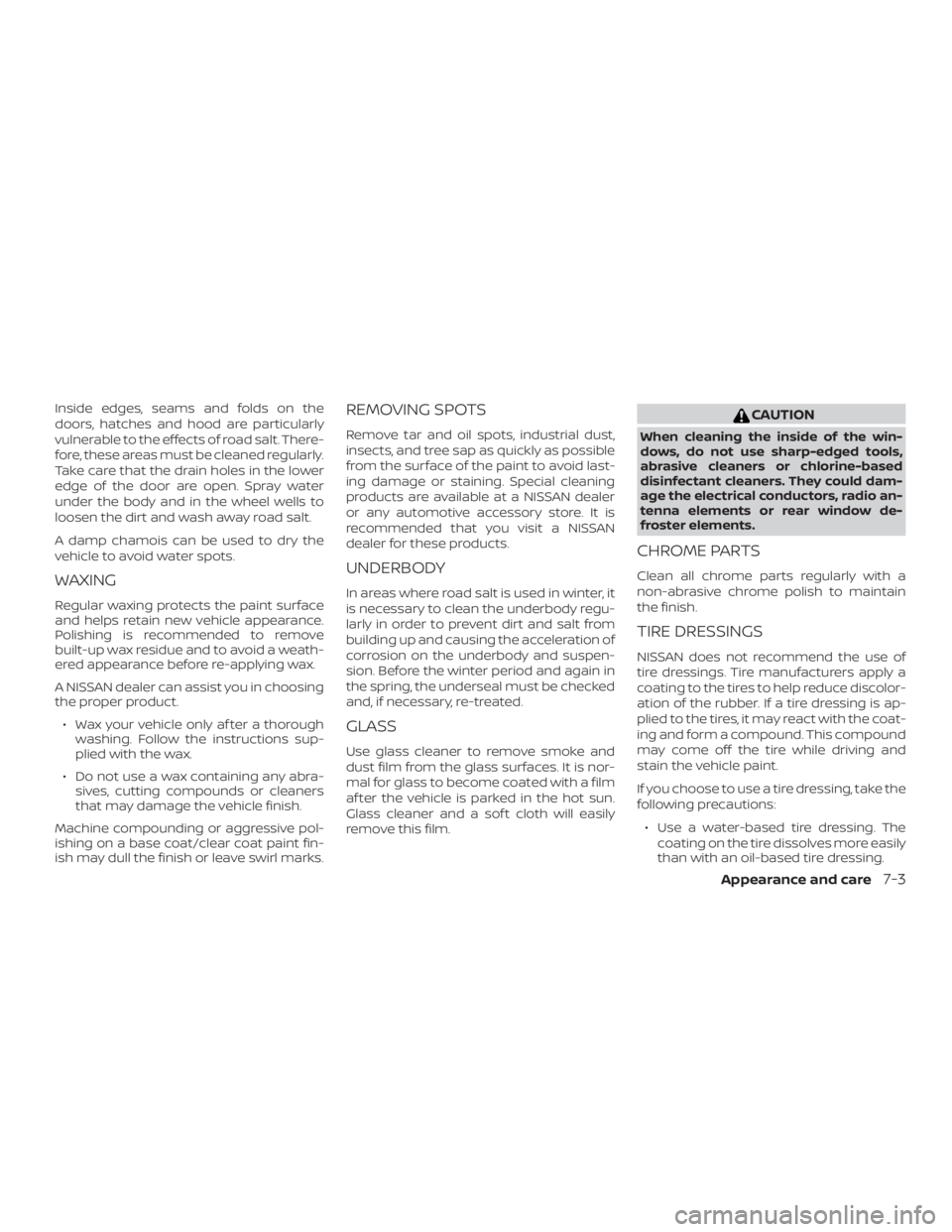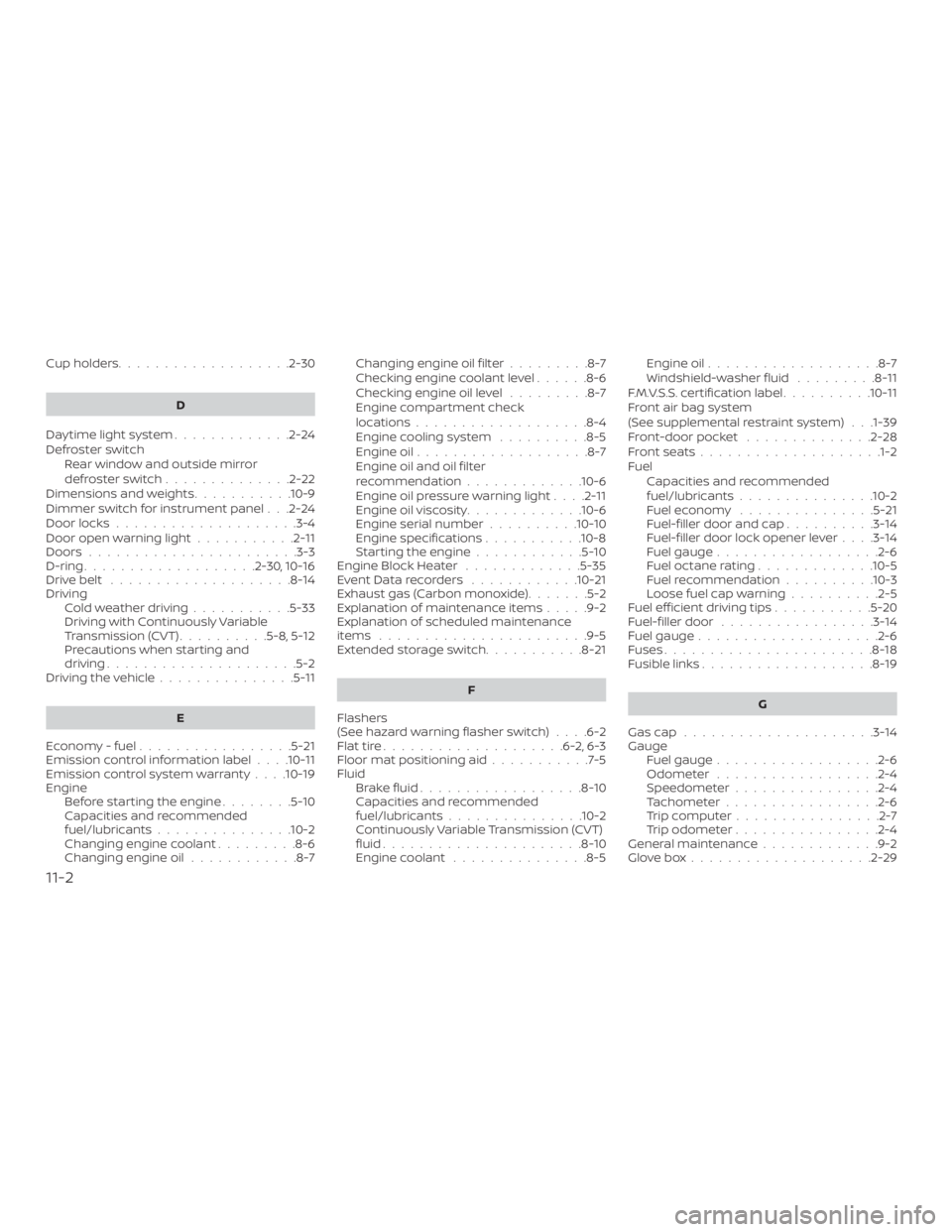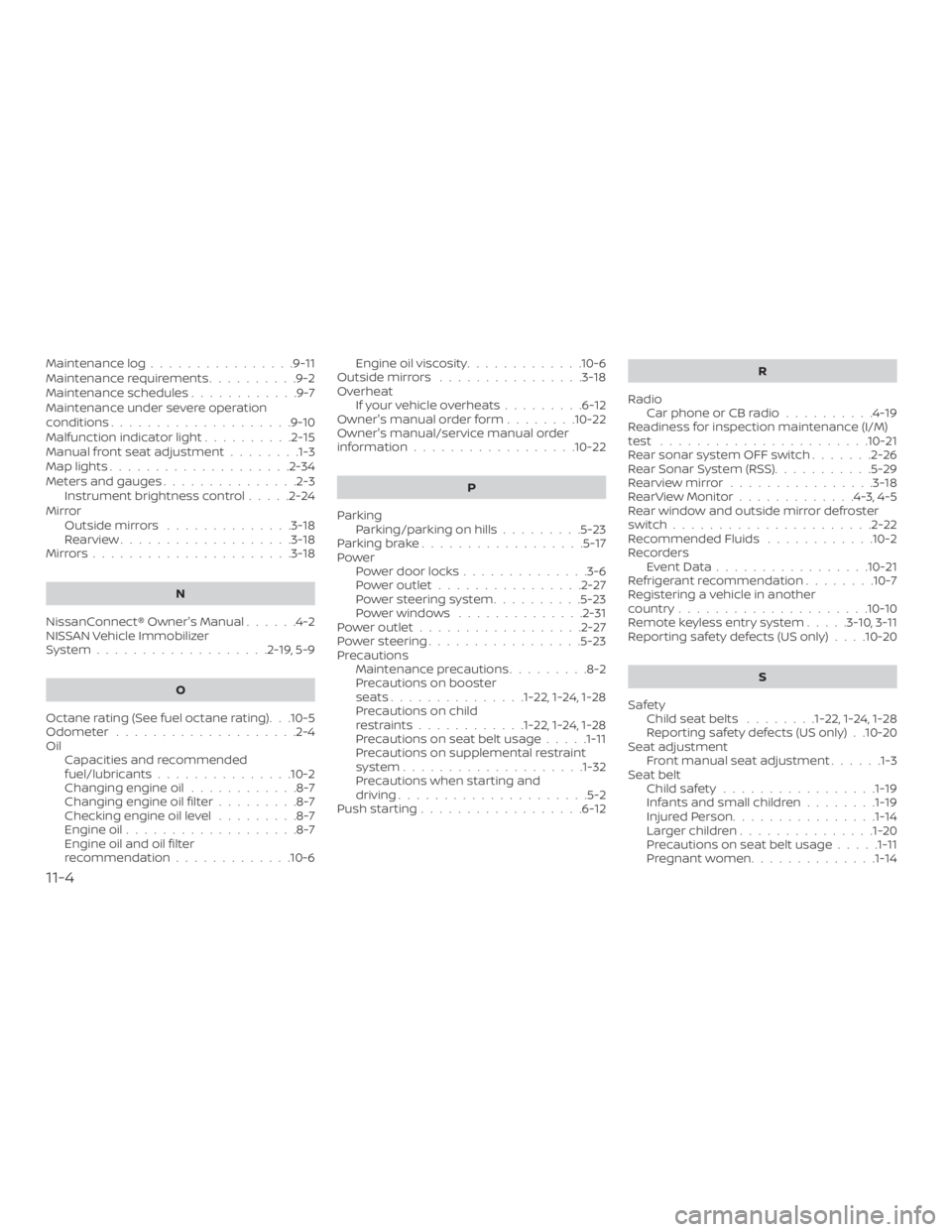2020 NISSAN NV200 recommended oil
[x] Cancel search: recommended oilPage 147 of 300

The air conditioner system in your NISSAN
vehicle is charged with a refrigerant de-
signed with the environment in mind.
This refrigerant does not harm the
earth’s ozone layer.
Special charging equipment and lubricant
is required when servicing your NISSAN air
conditioner. Using improper refrigerants or
lubricants will cause severe damage to
your air conditioner system. For additional
information, refer to “Air conditioner sys-
tem refrigerant and oil recommendations”
in the “Technical and consumer informa-
tion” section of this manual.
It is recommended that you visit a NISSAN
dealer to service your “environmentally
friendly” air conditioner system.
Page 160 of 300

∙ Make sure the area around the vehicle isclear.
∙ Check fluid levels such as engine oil, coolant, brake fluid, and windshield-
washer fluid as frequently as possible,
or at least whenever you refuel.
∙ Check that all windows and lights are clean.
∙ Visually inspect tires for their appear- ance and condition. Also check tires for
proper inflation.
∙ Check that all doors are closed.
∙ Position seat and adjust head restraints/headrests.
∙ Adjust inside and outside mirrors.
∙ Fasten seat belts and ask all passen- gers to do likewise.
∙ Check the operation of warning lights when the ignition switch is placed in the
ON position. For additional information,
refer to “Warning lights, indicator lights
and audible reminders” in the “Instru-
ments and controls” section of this
manual. 1. Apply the parking brake.
2. Move the shif t lever to P (Park) or N
(Neutral). P (Park) is recommended.
The shif t lever cannot be moved out
of P (Park) and into any of the other
gear positions if the ignition switch
is turned to the OFF position or if the
key is removed from the ignition
switch.
The starter is designed not to oper-
ate if the shif t lever is in any of the
driving positions.
3. Crank the engine with your foot off
the accelerator pedal by placing the
ignition switch in the START position.
Release the key when the engine
starts. If the engine starts, but fails to
run, repeat the above procedure.
∙ If the engine is very hard to start in extremely cold weather or when re-
starting, depress the accelerator
pedal a little (approximately 1/3 to the
floor) and hold it and then crank the
engine. Release the key and the ac-
celerator pedal when the engine
starts.
∙ If the engine is very hard to start be- cause it is flooded, depress the accel- erator pedal all the way to the floor
and hold it. Crank the engine for
5–6 seconds. Af ter cranking the en-
gine, release the accelerator pedal.
Crank the engine
with your foot off
the accelerator pedal by turning the
ignition key to the START position. Re-
lease the key when the engine starts.
If the engine starts, but fails to run,
repeat the above procedure.
Page 205 of 300

Inside edges, seams and folds on the
doors, hatches and hood are particularly
vulnerable to the effects of road salt. There-
fore, these areas must be cleaned regularly.
Take care that the drain holes in the lower
edge of the door are open. Spray water
under the body and in the wheel wells to
loosen the dirt and wash away road salt.
A damp chamois can be used to dry the
vehicle to avoid water spots.
WAXING
Regular waxing protects the paint surface
and helps retain new vehicle appearance.
Polishing is recommended to remove
built-up wax residue and to avoid a weath-
ered appearance before re-applying wax.
A NISSAN dealer can assist you in choosing
the proper product.∙ Wax your vehicle only af ter a thorough washing. Follow the instructions sup-
plied with the wax.
∙ Do not use a wax containing any abra- sives, cutting compounds or cleaners
that may damage the vehicle finish.
Machine compounding or aggressive pol-
ishing on a base coat/clear coat paint fin-
ish may dull the finish or leave swirl marks.
REMOVING SPOTS
Remove tar and oil spots, industrial dust,
insects, and tree sap as quickly as possible
from the surface of the paint to avoid last-
ing damage or staining. Special cleaning
products are available at a NISSAN dealer
or any automotive accessory store. It is
recommended that you visit a NISSAN
dealer for these products.
UNDERBODY
In areas where road salt is used in winter, it
is necessary to clean the underbody regu-
larly in order to prevent dirt and salt from
building up and causing the acceleration of
corrosion on the underbody and suspen-
sion. Before the winter period and again in
the spring, the underseal must be checked
and, if necessary, re-treated.
GLASS
Use glass cleaner to remove smoke and
dust film from the glass surfaces. It is nor-
mal for glass to become coated with a film
af ter the vehicle is parked in the hot sun.
Glass cleaner and a sof t cloth will easily
remove this film.
Page 290 of 300

Cupholders...................2-30D
Daytime light system .............2-24
Defroster switch Rear window and outside mirror
defrosterswitch..............2-22
Dimensions and weights ...........10-9
Dimmer switch for instrument panel . . .2-24
Door locks ....................3-4
Door open warning light ...........2-11
Doors .......................3-3
D-ring ...................2-30,10-16
Drivebelt ....................8-14
Driving Coldweatherdriving...........5-33
Driving with Continuously Variable
Transmission (CVT) ..........5-8,5-12
Precautions when starting and
driving .....................5-2
Drivingthevehicle...............5-11
E
Economy - fuel .................5-21
Emission control information label . . . .10-11
Emission control system warranty . . . .10-19
Engine Before starting the engine ........5-10
Capacities and recommended
fuel/lubricants...............10-2
Changing engine coolant .........8-6
Changing engine oil ............8-7 Changing engine oil filter
.........8-7
Checking engine coolant level ......8-6
Checking engine oil level .........8-7
Engine compartment check
locations...................8-4
Engine cooling system ..........8-5
Engine oil ...................8-7
Engine oil and oil filter
recommendation .............10-6
Engine oil pressure warning light ....2-11
Engine oil viscosity .............10-6
Engine serial number ..........10-10
Engine specifications ...........10-8
Starting the engine ............5-10
Engine Block Heater .............5-35
EventDatarecorders ............10-21
Exhaust gas (Carbon monoxide) .......5-2
Explanation of maintenance items .....9-2
Explanation of scheduled maintenance
items .......................9-5
Extended storage switch ...........8-21
F
Flashers
(See hazard warning flasher switch) ....6-2
Flattire....................6-2,6-3
Floormatpositioningaid...........7-5
Fluid Brakefluid..................8-10
Capacities and recommended
fuel/lubricants...............10-2
Continuously Variable Transmission (CVT)
fluid......................8-10
Engine coolant ...............8-5 Engine oil
...................8-7
Windshield-washer fluid .........8-11
F.M.V.S.S. certification label ..........10-11
Front air bag system
(See supplemental restraint system) . . .1-39
Front-door pocket ..............2-28
Frontseats....................1-2
Fuel Capacities and recommended
fuel/lubricants...............10-2
Fuel economy ...............5-21
Fuel-filler door and cap ..........3-14
Fuel-filler door lock opener lever . . . .3-14
Fuel gauge ..................2-6
Fueloctanerating.............10-5
Fuel recommendation ..........10-3
Loosefuelcapwarning..........2-5
Fuel efficient driving tips ...........5-20
Fuel-filler door .................3-14
F
uel gauge ....................2-6
Fuses .......................8-18
Fusiblelinks...................8-19
G
Gascap .....................3-14
Gauge Fuel gauge ..................2-6
Odometer ..................2-4
Speedometer ................2-4
Tachometer .................2-6
Trip computer ................2-7
Trip odometer ................2-4
General maintenance .............9-2
Glovebox....................2-29
11-2
Page 292 of 300

Maintenance log................9-11
Maintenance requirements ..........9-2
Maintenance schedules ............9-7
Maintenance under severe operation
conditions....................9-10
Malfunctionindicatorlight..........2-15
Manual front seat adjustment ........1-3
Maplights....................2-34
Meters and gauges ...............2-3
Instrument brightness control .....2-24
Mirror Outsidemirrors ..............3-18
Rearview...................3-18
Mirrors......................3-18
N
NissanConnect® Owner's Manual ......4-2
NISSAN Vehicle Immobilizer
System...................2-19,5-9
O
Octane rating (See fuel octane rating). . .10-5
Odometer ....................2-4
Oil Capacities and recommended
fuel/lubricants...............10-2
Changing engine oil ............8-7
Changing engine oil filter .........8-7
Checking engine oil level .........8-7
Engine oil ...................8-7
Engine oil and oil filter
recommendation .............10-6 Engine oil viscosity
.............10-6
Outsidemirrors ................3-18
Overheat Ifyourvehicleoverheats.........6-12
Owner's manual order form ........10-22
Owner's manual/service manual order
information..................10-22
P
Parking Parking/parkingonhills.........5-23
Parkingbrake..................5-17
Power Power door locks ..............3-6
Poweroutlet................2-27
Powersteeringsystem..........5-23
Powerwindows ..............2-31
Poweroutlet..................2-27
Powersteering.................5-23
Precautions Maintenance precautions .........8-2
Precautions on booster
seats...............1-22, 1-24, 1-28
Precautions on child
restraints............1-22, 1-24, 1-28
Precautions on seat belt usage .....1-11
Precautions on supplemental restraint
system ................... .1-32
Precautions when starting and
driving.....................5-2
Push starting ..................6-12 R
Radio Car phone or CB radio ..........4-19
Readiness for inspection maintenance (I/M)
test .......................10-21
Rear sonar system OFF switch .......2-26
Rear Sonar System (RSS) ...........5-29
Rearviewmirror................3-18
RearViewMonitor.............4-3,4-5
Rear window and outside mirror defroster
switch......................2-22
Recommended Fluids ............10-2
Recorders EventData.................10-21
Refrigerant recommendation ........10-7
Registering a vehicle in another
country .....................10-10
Remote keyless entry system .....3-10,3-11
Reporting safety defects (US only) . . . .10-20
S
Safety Childseatbelts ........1-22, 1-24, 1-28
Reporting safety defects (US only) . .10-20
Seat adjustment Front manual seat adjustment ......1-3
Seat belt Childsafety................ .1-19
Infants and small children ........1-19
I
njuredPerson............... .1-14
Largerchildren.............. .1-20
Precautionsonseatbeltusage.....1-11
Pregnant women ..............1-14
11-4